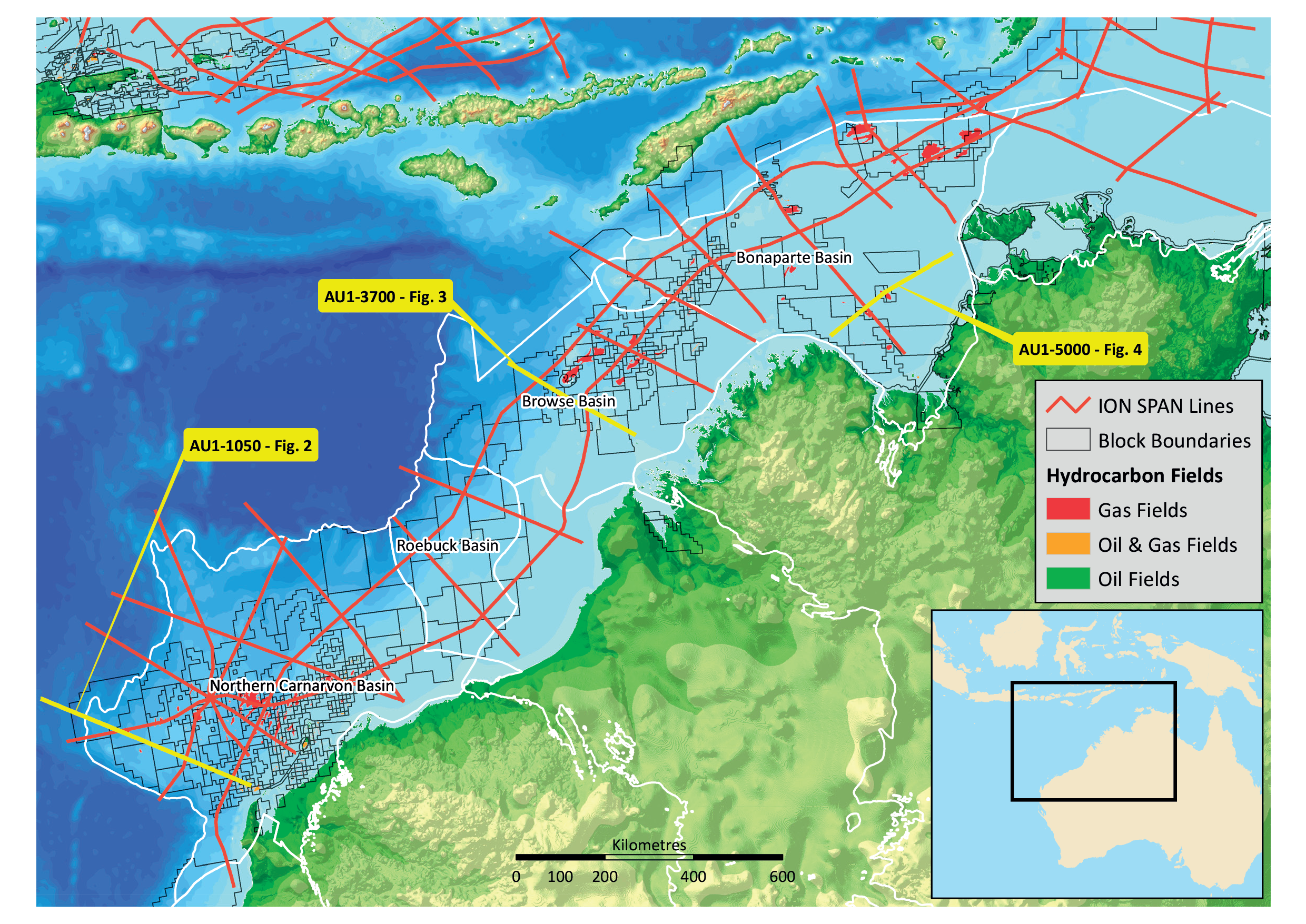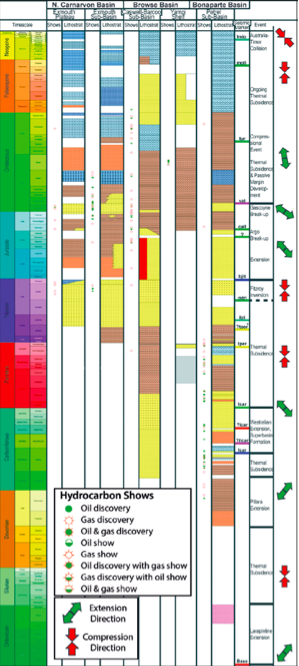
A developing province
With an estimated remaining undiscovered potential of 4.6 Bbo and 225 Tcfg, there is still much to explore for in the North West Shelf of Australia
The North West Shelf (NWS) can be divided into four major basin areas (Figure 1), each with a number of working petroleum plays from Permian to Cretaceous:
- The North Carnarvon Basin with its major gas plays on the Exmouth Plateau and oil plays in the Barrow/ Dampier sub-basins. The area is characterised by the thick Permo-Triassic Mungaroo Delta section, thin or absent crust and Jurassic/Cretaceous deformation (Figure 2).
- The Roebuck Basin contains a thick Permo-Carboniferous section, reaching 15 km thickness in parts of the Rowley sub-basin. The overlying Triassic and Lower Jurassic systems provide good reservoirs and have recently been proven as a significant oil play with the Phoenix South discovery. These units thicken to the north-west only to be abruptly truncated at the margin.
- The Browse Basin deepens rapidly at a crustal necking zone at the edge of the Kimberley Craton (Figure 3) with the various sub-basins filled with thick fluvio- deltaic Carboniferous and marine Permian sediments as a record of the Westralia event (Figure 5). Carbonate dominated sedimentation started in the Turonian and continued through to the Oligocene.
- The Bonaparte Basin and Petrel sub-basin (Figure 4) contain over 20 km of fairly continuous stratigraphy from the Palaeozoic to the present day, largely uninterrupted by significant faulting since the Carboniferous. The thickening sediment section coincides with dramatic thinning of the crust to potential mantle exhumation.
The NWS and its constituent basins and sub-basins have been subjected to, and modified by, multiple tectonic events with different orientations and extents, each well defined in the ION WestraliaSPAN data (Figure 5).

The importance of quality data
Key to progressing our understanding of the NWS has been the availability of long- offset (10km), long-record (18s TWT), regional seismic data that have been pre-stack depth migrated (Figures 2–4). The WestraliaSPAN line layout includes true dip lines orientated so as to accurately image the structural grain of the NWS, while regional strike lines link the constituent basins of the Westralia Superbasin, providing regional links between the provinces of the NWS. This enables construction of regionally consistent models for the geological evolution of the NWS.

Beyond careful planning and acquisition, the use of ION’s latest imaging and velocity modelling capabilities are the basis for the results. Depth imaging enables complex structures to be viewed with true depth perspective, and permits the regional links between the different provinces to be calibrated. The improved imaging combined with better velocity modelling allows interpreters to see for the first time the full sedimentary section and underlying crustal architecture, distinguishing between what had previously been considered to be continental basement, and sediment.
Implications for future prospectivity
Both the North Carnarvon and Bonaparte Basins (Petrel sub-basin) are characterised by thick sediment accumulations, up to 20 km and 24 km respectively. Multiple rifting phases have resulted in hyper-extension of the crust and possibly extensive mantle exhumation in these basins. Sediment supply has generally kept pace with the creation of accommodation space, with sediment having been deposited directly onto exhumed continental lithospheric mantle (Figures 2 and 3). A striking feature of the NWS is that it contains an almost complete record of sedimentation throughout the entire Phanerozoic (Figure 5). This is due to the protracted and polyphase nature of stretching events along the NWS, and the comparatively limited periods of uplift and erosion.
The thick sediment sections raise a number of questions and implications for the prospectivity of the basins. The anomalous sediment thicknesses are difficult to balance with traditional crustal extension and subsidence models. Models of hyper-extension and/or mantle exhumation are required to isostatically provide the accommodation space to allow for such deep basins. These models have significant uncertainties as the process of serpentinisation of the underlying lithospheric mantle is extremely difficult to constrain in terms of its extent and impact on density and heat flow. In general, serpentinisation will decrease density and thus suppress subsidence.

In addition, the process of multiphase extension with relatively long time periods between events (see Figure 5) means that the thermal effects of previous rift events will be largely dissipated by the time of the next event, and that both deep sediment and partially serpentinised lithospheric mantle from previous events may be acting essentially as continental crust in later events.
Finally, once the sediment pile reaches a certain thickness, progressively higher grade metamorphism will occur. We can see evidence for this on AU1-5000 (Figure 3) where reflections that appear to be characteristically sedimentary have seismic velocities in the region of 5.5 – >6 kms-1. This increase in seismic velocity (and implicitly density) will serve to drive additional subsidence, creating accommodation space for further sediments.
These competing factors driving the subsidence of the margin at different times and in different ways have implications for heat flow and thermal maturation of source rocks. Interpretation of the deep seismic data of the WestraliaSPAN survey provides an image of the architecture, allowing explorers to constrain the structural evolution and integrate existing heat flow and geochemical data to better understand petroleum system history.




